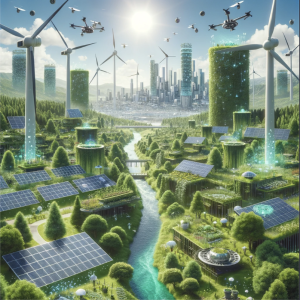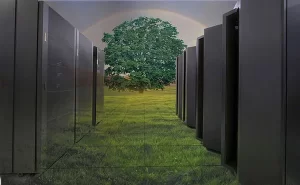
In the rush to advance artificial intelligence (AI), we’re overlooking something critical: its environmental footprint. As technology is growing at an unprecedented rate, the environmental costs are accumulating too – a problem we can no longer afford to ignore. Environmental protection must be integrated into the core of AI innovation, not treated as an optional add-on. We cannot delay action any longer. Prioritizing the planet’s health is not just a moral obligation, but also a necessity for ensuring sustainable advancement of AI.
The Environmental Costs of AI
AI consumes huge amounts of energy and water in order to work, leading to a massive CO2 footprint. But brace yourself, for this problem will only get worse. As AI services become more widespread and the employed models will grow even larger they will inflict substantial environmental harm in the near future, potentially spiraling beyond our control.
Consider this: Researchers estimate that GPT-3 consumes about 500ml of water, equivalent to a standard-sized water bottle, for every 20 questions it answers. However, this is just the beginning. The Guardian pointed out that with the introduction of GPT-4 our AI models are likely to become even thirstier.
Training GPT-3 alone consumed a staggering 1,287MWh of electricity and led to carbon dioxide emissions exceeding 550 tons, comparable to taking 550 round-trip flights between New York and San Francisco. Data centers currently generate 3.5% of all global greenhouse gas emissions, surpassing the airline industry.

Let’s put things into perspective: GPT-4, the next AI-generation, boasts approximately 570 times more parameters than its predecessor GPT-3. While this doesn’t necessarily mean it consumes precisely 570 times more energy and water, it does signal an intensification of the consumption of resources as AI evolves.
As technology analyst Gartner pointed out: unless we undergo a radical reevaluation of how we develop AI systems, by the year 2030, the energy consumption of AI applications could surpass that of the entire human workforce. By 2040, data centres can be responsible for as much as 14% of the world’s carbon output.
AI as a Solution for Climate Change?
Some may point out the potential of AI to tackle climate change issues. They argue that AI will optimize energy, predict environmental risks, and even reforest our planet. However, the reliance on AI for environmental sustainability is a paradox; we cannot let the solution be part of the problem.
“If you want to save the planet with AI, you have to consider the environmental footprint of AI first. It doesn’t make sense to burn a forest and then use AI to track deforestation.”
Sasha Luccioni, The Guardian
It is going to take more than smart algorithms to tackle climate change. It’s about changing the way we live, the way we consume, and importantly: the way we innovate. Using AI as a tool for environmental protection without first addressing its environmental impact will contribute more to the problem than it aims to mitigate.
AI’s Dilemma
Researchers are trying to find ways to maintain the development of AI without the huge negative environmental impacts. But it’s difficult. The ultimate question arises; are we willing to make the trade-off between AI performance and the environmental good of our planet? The answer to this question holds the key to our sustainable future.
We argue that environmental degradation is an existential threat to humanity. Prioritizing environmental protection over AI innovation is an investment in our future. Overall, AI innovations should not come at the expense of the environment. We need to rethink the use of AI fast. The situation is serious and requires immediate action now.
Yet, it is natural to question whether the big tech companies with their vested interest will willingly make the necessary sacrifices in AI performance to mitigate the ecological impact AI is causing. Thus, we are compelled to consider tangible steps that can be taken in the real world, both individually and collectively, to shield our planet from further harm.
A Call for Actions
In the race to harness the potential of AI, we cannot afford to disregard its environmental consequences. The path forward must balance environmental protection with AI innovation. Thus, we need to take action to protect the environment and find ways to develop and deploy AI responsibly. Our future, and that of the generations to come, depends on it. We will therefore continue to discuss three concrete calls for action.

1. More Transparency
AI applications have seamlessly integrated into our lives, earning widespread acceptance and adoration from the general public. Yet, beneath the hype of innovation and convenience, there is a concerning, deliberative silence surrounding the environmental impact of AI.
Researchers are trying with difficulty to quantify the environmental impact of AI. But both the companies responsible for popular AI tools as well as companies selling the chips that power AI systems are reluctant to reveal details about the energy consumption of AI systems.
In 2018, OpenAI published an environmental report that has become a key reference point in the literature. However, when OpenAI released its most advanced model GPT-4 five years later, they conveniently decided not to reveal the computational resources necessary for its training and operation.
Researchers call for greater incentives aimed at motivating industry developers to measure and openly report the environmental impact of their AI endeavors. To achieve this goal, governmental schemas should be established. Companies and public institutions should be mandated to provide detailed reports outlining the environmental costs entailed in the training and tuning of AI systems. By demanding such transparency, we create a pathway towards more responsible AI development.
2. Implement Regulations
Despite the advancements in many other sectors towards reducing environmental damage by shifting to renewable energy and following regulations, the field of AI has largely been overlooked. Reports about the substantial energy consumption and environmental impact of AI have been around for years, yet international governments have taken limited actions on these issues. While large tech companies such as Microsoft and Google have taken voluntary steps to mitigate some environmental impacts, there is no compulsory legislation to hold them accountable.
“Tech companies like to boast of their efforts to fight the climate crisis, but in practice, many are increasing their emissions in the current race to perfect AI capabilities.”
Viki Auslender & Shani Ashkenazi, Ctechnews
To address the gap in regulation, researchers proposed a policy that would mandate companies to ensure the carbon footprint and environmental impact when training or refining an AI model is proportional to the task at hand. Should the cost exceed predictions, they can be forced to stop. This is just one example that will urge the tech sector towards more environmental responsibility and nudge AI innovation to sustainable practices.
3. Increase Awareness
The environmental impact of AI often remains concealed from the public eye. Unlike physical objects, the underlying AI infrastructure is largely intangible. You can´t observe the cloud-based servers diligently at work, nor can you witness the chips racing through their memory to execute complex tasks. The massive volumes of water flowing through data centers to cool AI´s computational engines remain unseen to most.
This obscurity is a call for action. It is imperative that we take measures to educate the general public about the hidden costs of AI systems and their profound impact on the environment. Knowledge is the key to empowerment and by making these environmental costs visible, we empower each individual to reflect on their own use of AI applications.
Imagine a world where every user comprehends the ecological footprint of their AI interactions, from voice assistant to ChatGPt inquiries. This newfound awareness would trigger a collective awakening, compelling us to make more environmentally conscious choices in our daily consumption of AI applications.
Final Thoughts
In our rapidly evolving technological landscape, we find ourselves at a critical juncture where a harmonious coexistence between environmental preservation and AI innovation is imperative. We need to explore avenues that enable the responsible development and deployment of AI, while also taking actions to protect the environment.
The pursuit of AI innovation should not come at the cost of environmental degradation. Instead, it should be underpinned by a commitment to sustainable practices and responsible resource utilization. Thus, environmental protection must be integrated into the core of AI innovation. This means that moving forward, we should facilitate more transparency, implement governmental regulations, and increase awareness of AI´s impact on the environment among the general public.
Collaboration among stakeholders is the key to success. Together, we can navigate the complex terrain of AI innovation while safeguarding the delicate balance of our environment. It is through this collective effort that we can pave the way for a future where AI thrives, and our planet flourishes in harmony. The time to act is now, for the sake of generations to come.


